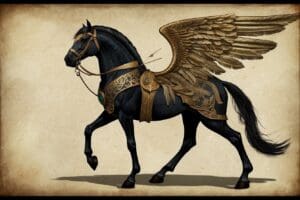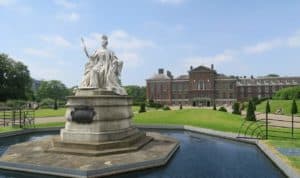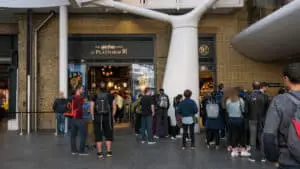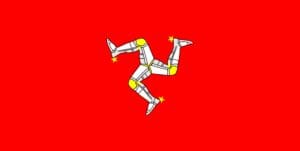Daily Life and Legendary Battles: An Insight into Medieval Ireland’s History
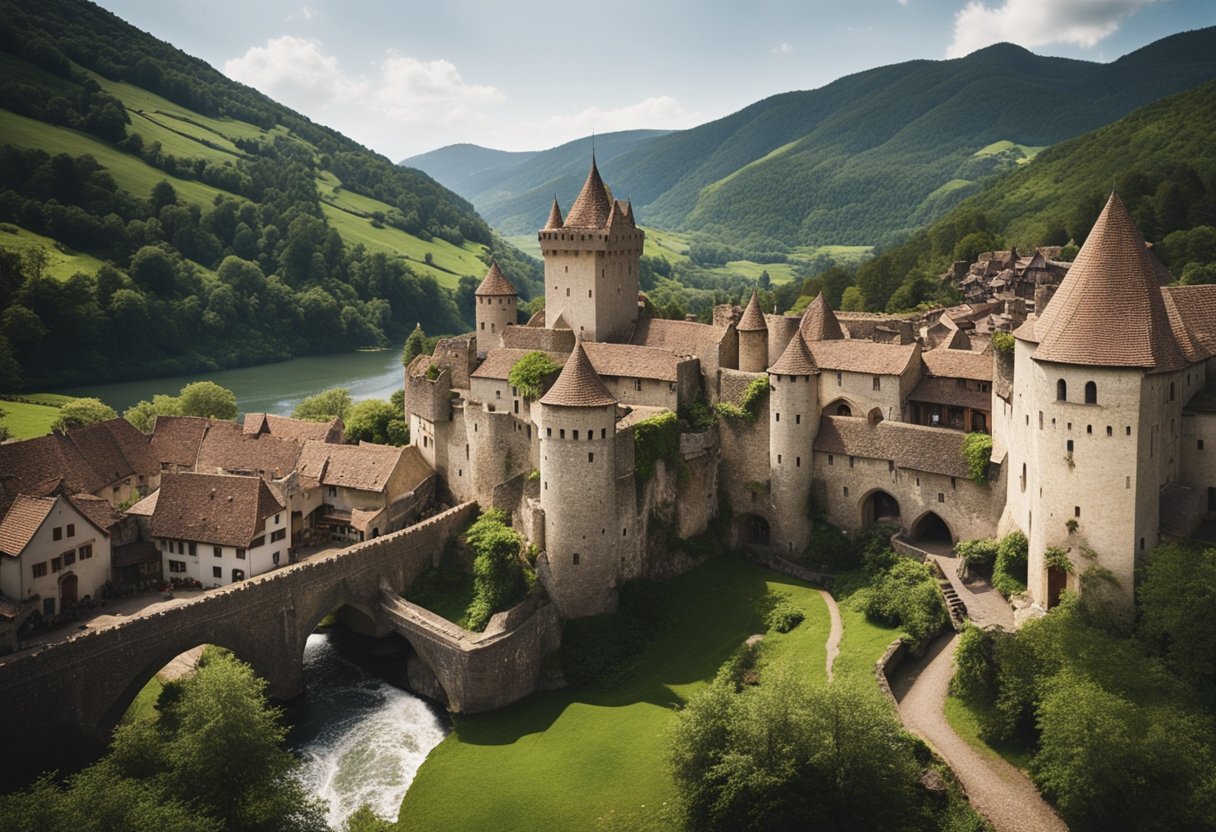
Updated On: April 22, 2024 by Maha Yassin
Medieval Ireland was a tapestry of cultural richness and fierce battles woven from the threads of daily life, legendary conflicts, and political intricacies. We can glimpse the essence of this era through the remains of its raths and roundhouses, markers of everyday life that tell us much about the social structures and domestic practices of the time. These ancient abodes, carefully reconstructed by experimental archaeologists, provide compelling insights into the lives led by those who called Ireland home during the medieval period.
As we explore further, the sagas and structures of the past draw us in—the looming castles and the tales of high kings and warriors that echo through the halls of history. Ireland’s legendary leaders, such as Brian Boru, shaped the geopolitical landscape, steering the course of epic conflicts and invasions that were pivotal in forging the nation’s identity. The remains of formidable fortresses scattered across the emerald landscape are stark reminders of the martial prowess and chivalric values that defined the era.
The Geopolitical Tapestry of Medieval Ireland
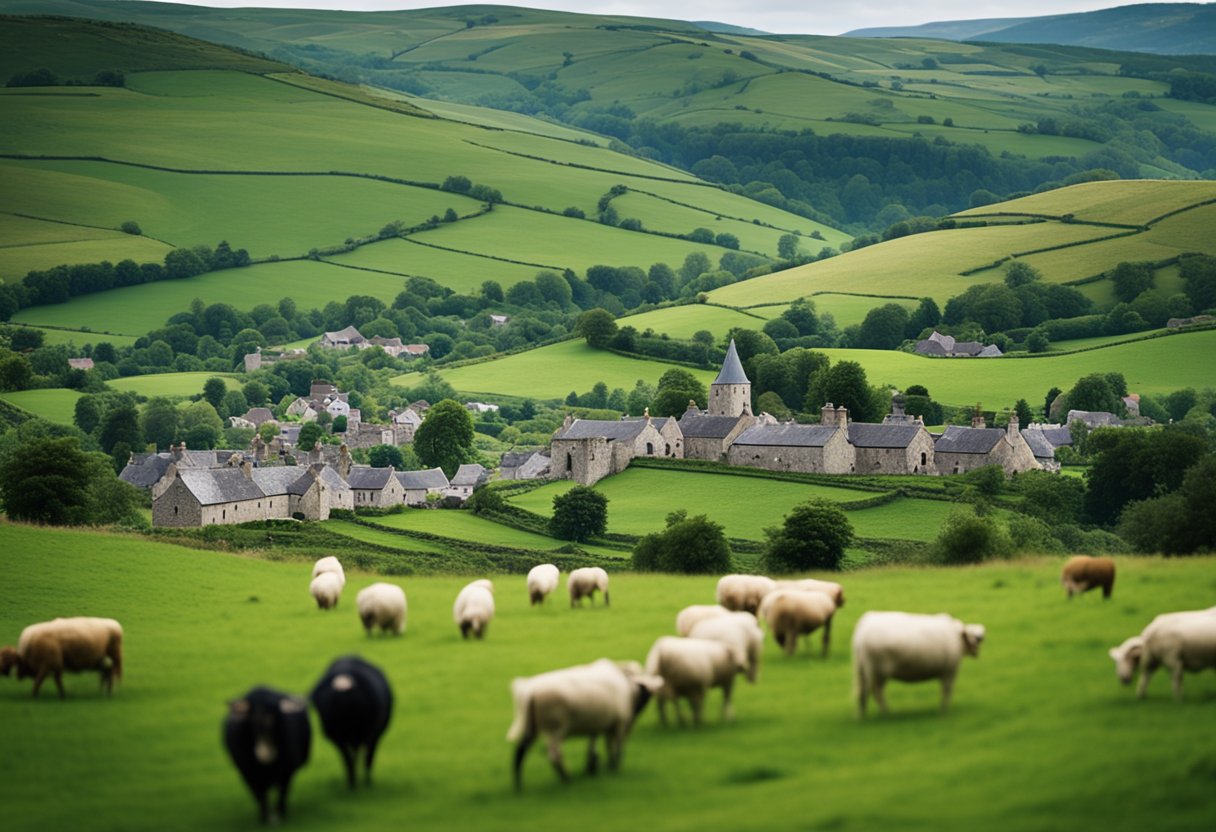
In Medieval Ireland, the geographical divide was not just of lands and seas but also of power and heritage. We witnessed the coexistence of various kingdoms, dynasties, and clans, shaping the Irish identity from the early medieval period into the Middle Ages and stretching to the 15th century.
Kingdoms and Provinces
- Leinster: At times, the seat of High Kings, such as in Kildare, Leinster’s landscape of power was as varied as its terrain, featuring established urban centres like Dublin and Wexford.
- Munster: Renowned for the seafaring stronghold of Waterford and the ecclesiastical significance of Cork and Limerick, Munster’s geopolitical influence was substantial.
- Connaught: Galway’s prosperity grew alongside Connaught’s other eminent territories, resisting encroachment and maintaining strong Gaelic Irish roots.
- Ulster: With the resilient spirit of Armagh, Ulster sustained its position despite repeated challenges, maintaining a deeply embedded Gaelic identity.
- Meath: Historically significant, the seat of the High Kings at Tara placed Meath at the epicentre of political and druidic power.
The Shift of Power
Throughout history, our understanding of Medieval Ireland has adapted. Dynastic struggles often drew in external forces, culminating in legendary battles that left indelible marks upon the land and its people. The arrival of the Normans heralded an era where the juxtaposition of native Gaelic clans and Anglo-Norman settlers led to a complex weave of cooperation and conflict.
Dublin and Beyond
Dublin emerged as a metropolitan hub, exerting control and influence upon surrounding areas, including regions such as Meath and Kildare. Beyond the Pale, the influence of Gaelic customs remained influential, particularly in rural Tipperary, where Gaelic rule resonated deeply.
As we explore the intertwined histories, it becomes clear that the geopolitical landscape of Medieval Ireland was a multifaceted one, with a vibrant array of jostling identities and dynamic cultural shifts throughout the ages.
Settlements and Structures
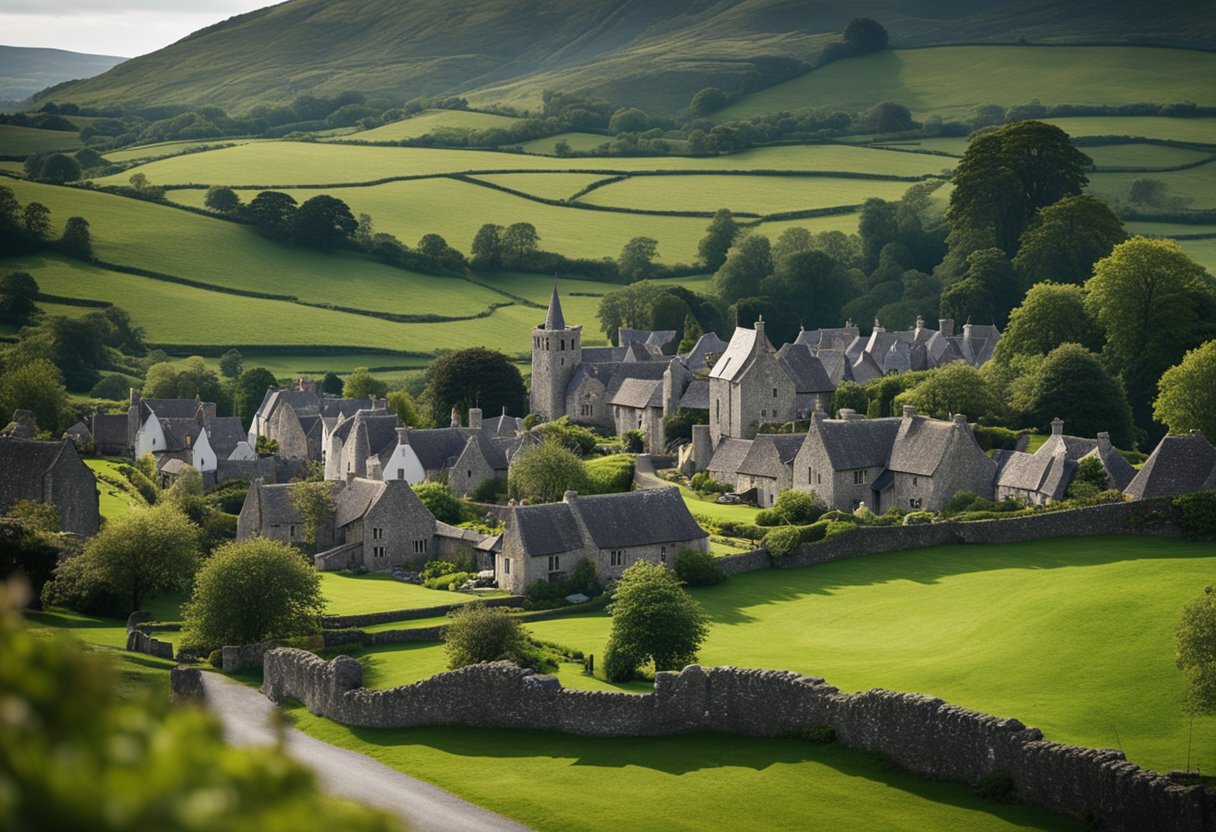
Medieval Ireland’s landscape was marked by various settlements and structures that served numerous social, economic, and religious purposes. The most common early medieval settlement enclosure type was the rath, a fortified homestead typically found in the Irish countryside. These settlements were home to the living spaces, known as dwellings, and the fields essential for agriculture and trade.
In terms of buildings, these enclosures often encompassed simple huts made from natural materials like wood, wattle, and daub. The purpose of such settlements extended beyond mere shelter; they were centres of domestic life and sometimes trade. Traders would travel between these settlements, fostering a network for the exchange of goods and services. The influence and domination of local chieftains were sometimes reflected in the size and complexity of the settlements’ defence structures.
The period also witnessed significant church reform, which influenced the construction of religious monasteries that became integral elements of the societal fabric. Known for their unique architecture, these monasteries served as spiritual centres and hubs of learning and manuscript production.
- Key Structures in Medieval Irish Settlements:
- Rath: A prevalent form of defence.
- Crannóg: Man-made islands used as dwellings.
- Promontory Forts: Coastal settlements with defensive features.
Our examination of these settlements and structures offers us deeper insights into medieval Ireland’s daily life and societal organisation. The remnants of such settlements continue to be a testament to the period’s architectural ingenuity and social stratification.
Legendary Leaders and High Kings
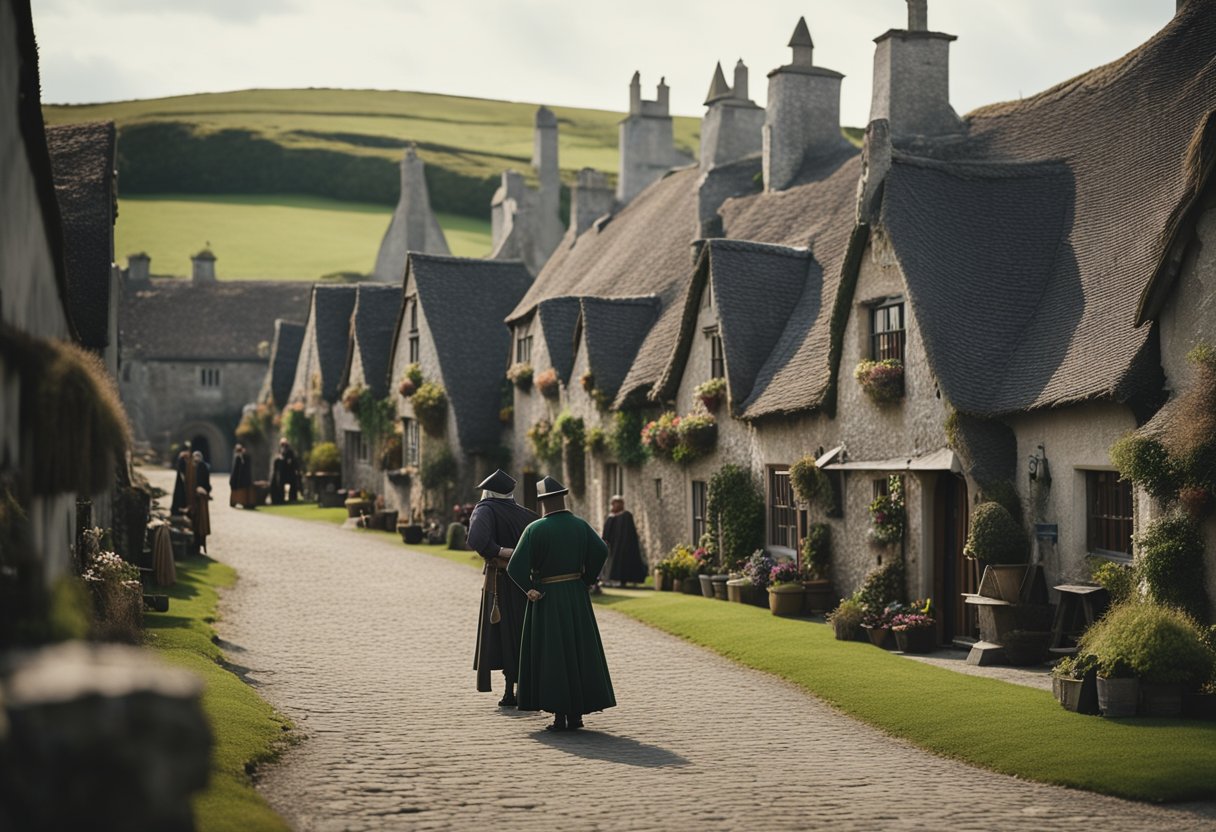
We observe that medieval Ireland was a land shaped by the rule and exploits of its legendary leaders and High Kings. The fabric of Irish society was woven with the threads of royal power and sovereignty, a complex tapestry of monarchies, clans, and nobles vying for jurisdiction and influence.
Brian Boru was one of the most renowned High Kings in Irish history, and he rose to prominence for his valiant efforts to consolidate Ireland under his rule. He secured his position at the seminal Battle of Clontarf in 1014, which remains etched into the annals of Irish lore. His reign marks one of the few times that relative peace was established among the various factions within Ireland.
The arrival of Edward Bruce in the 14th century, proclaiming himself High King of Ireland, introduced a period of upheaval. His invasion was a significant chapter, contributing to reshaping the control and territorial boundaries within the land. Although his campaign was ultimately short-lived, it played a pivotal role in highlighting the dynamics of power and the contested nature of the title of High King.
King Richard II of England also impacted Ireland during his two expeditions in the late 14th century, asserting external influence over Irish affairs. His attempts to strengthen the English hold over the Irish territories exemplify the external pressures Irish monarchies faced during the medieval period.
As we consider the legendary battles and leaders of the time, we must not forget the intricate societal structure that sustained their legendary deeds—the clans and nobility that supported and sometimes contested the High Kings’ rule. Through understanding these legendary figures and their tumultuous reigns, we grasp the complex legacy of leadership in medieval Ireland.
Epic Conflicts and Invasions
Medieval Ireland was shaped by an array of epic conflicts and invasions, from the Viking raids that brought terror and trade to the island to the Anglo-Norman invasions, dramatically altering the political landscape.
The Norman Incursion
The Norman incursion into Ireland represented a significant turning point in our history. In 1169, the Norman knight Richard de Clare, colloquially known as Strongbow, landed near Waterford at the behest of Diarmuid MacMurrough, the ousted King of Leinster, who sought aid in reclaiming his throne. The subsequent arrival of Normans heralded the beginning of significant socio-political change and the introduction of feudal structures in the Irish territories they conquered.
The Viking Raids
Beginning in the 8th century, the Viking raids were a fearsome thread in the tapestry of our heritage. The Norsemen targeted monastic settlements like Armagh with their longships, sacking treasures and establishing coastal strongholds that became thriving Norse-Gaelic towns. Despite their initial roles as invaders, the Vikings later integrated into Irish society, contributing to our urban development and commerce. The Battle of Clontarf in 1014, where Brian Boru, High King of Ireland, sought to quash Norse power, stands out as a landmark battle in which axes and swords clashed to shape our collective destiny.
The Anglo-Norman Invasion
The Anglo-Norman invasion, which began in 1169, further disrupted the fabric of Irish rule. Notable figures such as Hugh de Lacy established a strong Anglo-Norman presence, erecting castles to enforce their domain and introducing the full complement of medieval armour. By the time of the Battle of Tara in 980, where Máel Sechnaill mac Domnaill faced off against the Norse king Olaf Cuaran, this integration of foreign influences was already setting the stage for future conflicts like the Wars of the Roses, with its impact echoing through to the 15th century. The invasion entrenched the Anglo-Norman control over large swaths of Ireland and complicated our relationships with England and other European powers.
The Political Machinery of Medieval Irish
Medieval Ireland’s political landscape was characterised by a tapestry of dynamic power structures and governance that evolved significantly over time. The Irish Parliament, rooted in English common law, was a foundational institutional element of royal jurisdiction. Under King John’s lordship, the introduction of English law fortified royal power and set a precedent for centralised governance.
Medieval Irish society was divided into numerous dynasties and noble families, such as the O’Donnells, who wielded considerable regional power. Political influence also extended to the clergy, with ecclesiastical figures playing pivotal roles in spiritual and temporal affairs. The Chancery, an office derived from Roman institutions, managed the administration, underscoring the complex interplay between native traditions and external influences.
The medieval period was punctuated by legendary confrontations, with the Battle of Clontarf serving as a seminal moment in asserting sovereignty against external threats. Despite incursions, Roman forces never fully subsumed Ireland, maintaining a unique political identity throughout its history.
| Entity | Role |
|---|---|
| Irish Parliament | Legislative Assembly |
| Chancery | Administrative Office |
| King John | Centralising Force |
| Dynasties & Nobles | Ruling Entities |
We recognise that the political mechanisms of medieval Ireland were shaped by a harmony of inherited systems and the grafting of new legal and administrative practices. From local chieftains to ecclesiastical figures, sovereignty and authority were vested in individuals and institutions, reflecting the period’s evolving socio-political ethos.
The Social and Economic Foundations
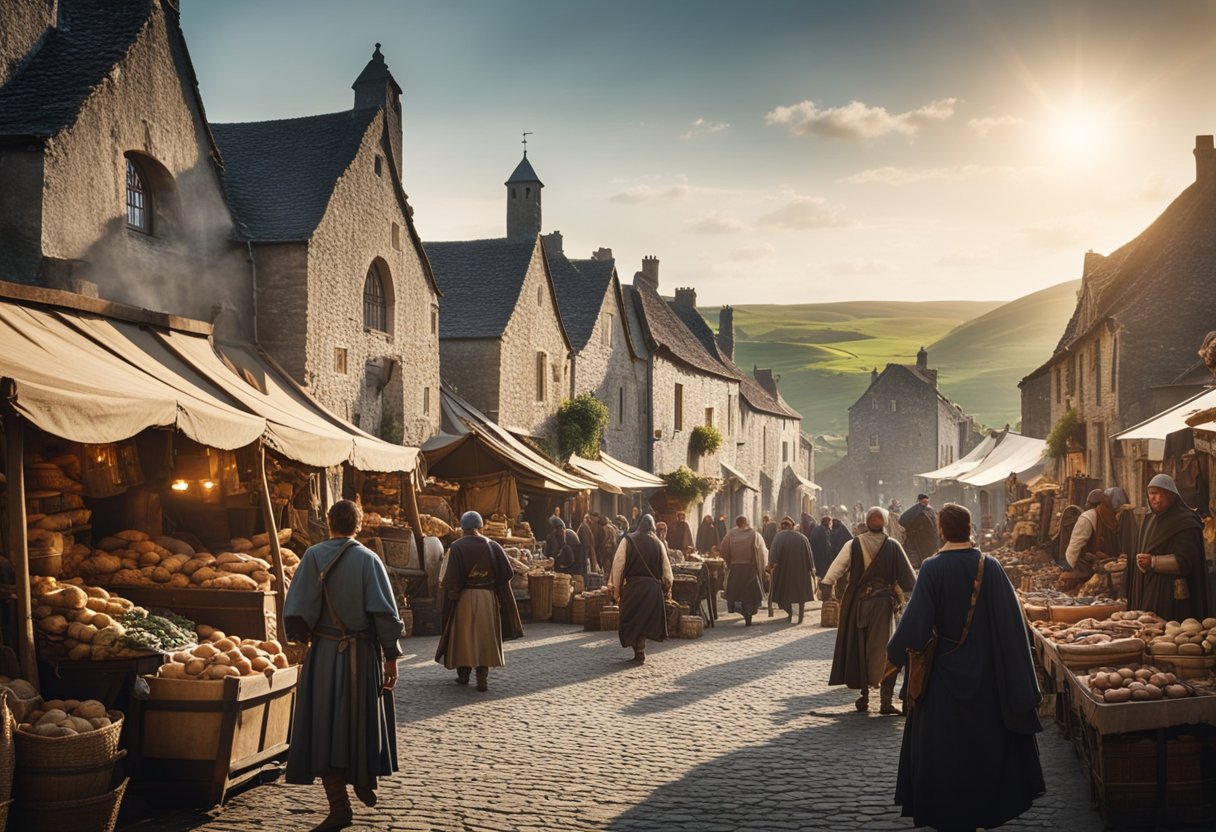
In medieval Ireland, the fabric of society was woven from the industry of its people and the wealth they created. We can observe that aristocratic families and the clergy were the pillars of this structure, wielding economic and social power.
The working class, primarily composed of peasants, engaged in labour on arable land, ensuring that the basic sustenance of society was met through crop cultivation. The church or nobility often controlled these lands, with peasants working as tenants. Building techniques varied from simple wooden structures in rural areas to grand stone fortifications that signified power and defensive capabilities.
Trade was a cornerstone of development, with local markets hubs for exchange and coastal towns engaging in sea trade. Goods such as wool, leather, and hides were commonly traded, providing the necessary impetus for economic progress.
Settlements in medieval Ireland ranged from small villages to larger towns. These became centres for commerce, culture, and governance, often protected by enclosing walls to ward off attacks.
During this period, the Reformation brought about significant change, particularly impacting the wealth and influence of the church, which in turn caused ripples through the economic and social spheres.
As we explore medieval Ireland, it’s evident that these social and economic foundations were robust and in a constant state of evolution, reflecting the complex tapestry of life during these times.
Cultural and Scholarly Pursuits
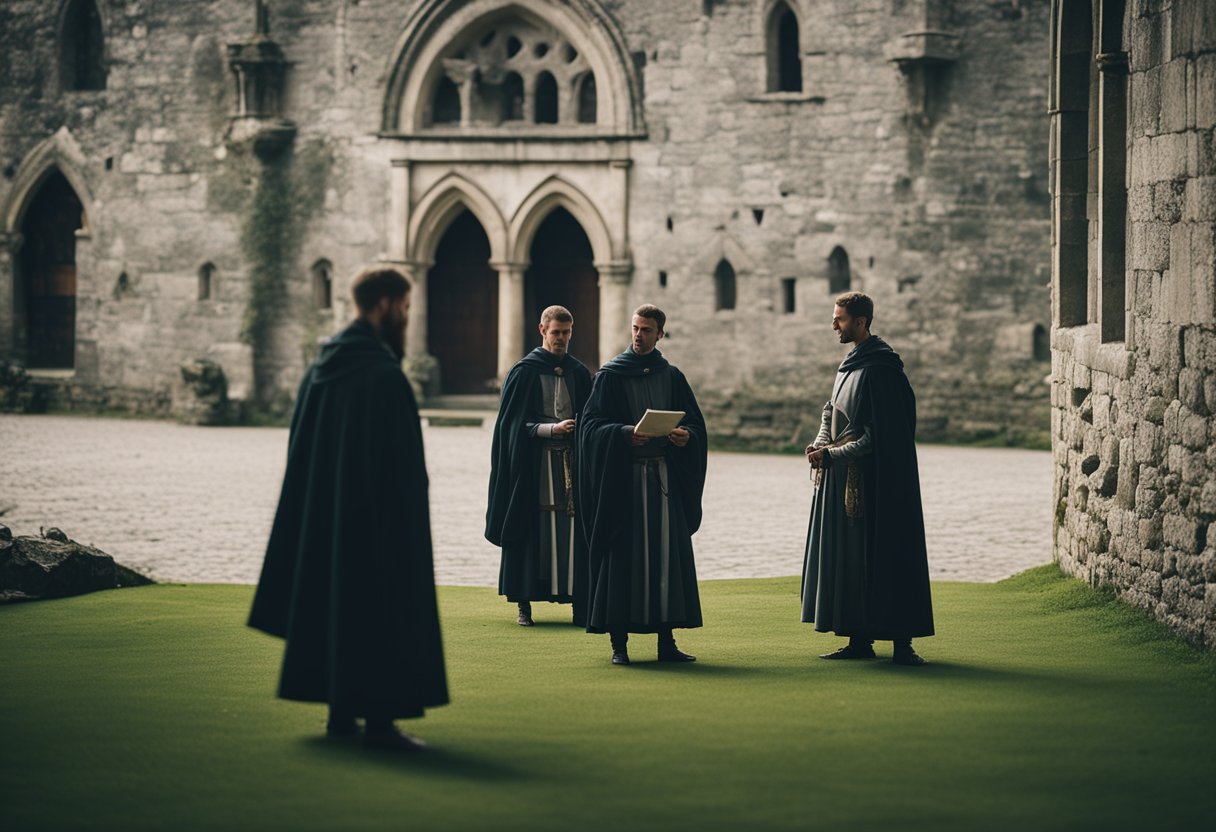
In medieval Ireland, cultural and scholarly pursuits were central to the fabric of society. Monasteries served not only as places of religious observance but also as beacons of learning and literature. They offered lectures and scriptural discussions, preserving knowledge that would have otherwise been lost.
The reform movements that swept through these institutions often had broader cultural implications. For example, the church reform that occurred at Clontarf and across Meath championed a return to monastic piety and scriptural purity, which, in turn, cultivated an environment where scholarly activities flourished.
Trade, the lifeblood of any thriving society, introduced many external influences to Ireland. With trade came a cross-pollination of ideas, allowing Irish culture to influence and be influenced by distant lands. Scholars often engaged in exchanges that extended beyond borders, sharing manuscripts, texts, and learning, which furthered intellectual pursuits.
We recognise the purpose of these scholarly activities in the context of devotion and their contribution to the chronicling and celebration of Irish heritage and identity. The literature from this period reflects a society rich in oral traditions, with historical tales and poetry committed to parchment, often accompanied by intricate illuminations.
Here’s how medieval Ireland’s scholarly framework can be broadly outlined:
- Monasteries: Centers for education, manuscript preservation, and literary creation.
- Church Reform: Catalysts for renewed scholarly vigour and scriptural engagement.
- Trade: Conduits for the exchange of ideas and scholarly materials.
- Literature: How history, mythology, and cultural values were recorded and celebrated.
Our collective journey into the past reveals the robust scholarly traditions underpinning medieval Ireland’s vibrant cultural landscape.
The Sagas of Warfare and Chivalry

In medieval Ireland, sagas of warfare and chivalry tell tales of valiant warriors and pivotal battles. The life of a knight in this era demanded mastery of the sword and axe, with battles such as the Battle of Clontarf defining the legacy of legendary figures like Brian Boru. His triumph over the Viking invaders in 1014 exemplifies the blend of bravery and tactics characteristic of the period.
Edward Bruce, the brother of Robert the Bruce, also played a crucial role in Irish history. His invasion in 1315 culminated at the Battle of Faughart in 1318, finally thwarting his campaign for the High Kingship of Ireland.
| Significant Battles | Notable Figures |
|---|---|
| Battle of Clontarf | Brian Boru |
| Battle of Faughart | Edward Bruce |
Chivalry was more than an ideal—it found embodiment in the Normans, such as Strongbow, who brought a feudal culture that emphasized honour and combat prowess. Yet, the harsh realities of medieval combat often belied the romanticised aspect of chivalry depicted in contemporary tales and ballads.
The Battle of Tara in 980 saw the forces of the Kings of Tara repelling Viking forces, with armour clashing against weaponry in the struggle for power and dominance. Knights and soldiers wielded various weapons, each a symbol of the era:
- Swords: A knight’s honour
- Axes: The brute force of the Viking raiders
- Armour: Protection in the melee of battle
We recognise these elements for their martial value and cultural significance, shaping the stories and history of medieval Ireland. As the pages of history unfurl, so do the sagas that resonate through time, immortalizing the strife and valour that once reigned in Ireland’s green landscapes.
Military Equipment and Fortifications
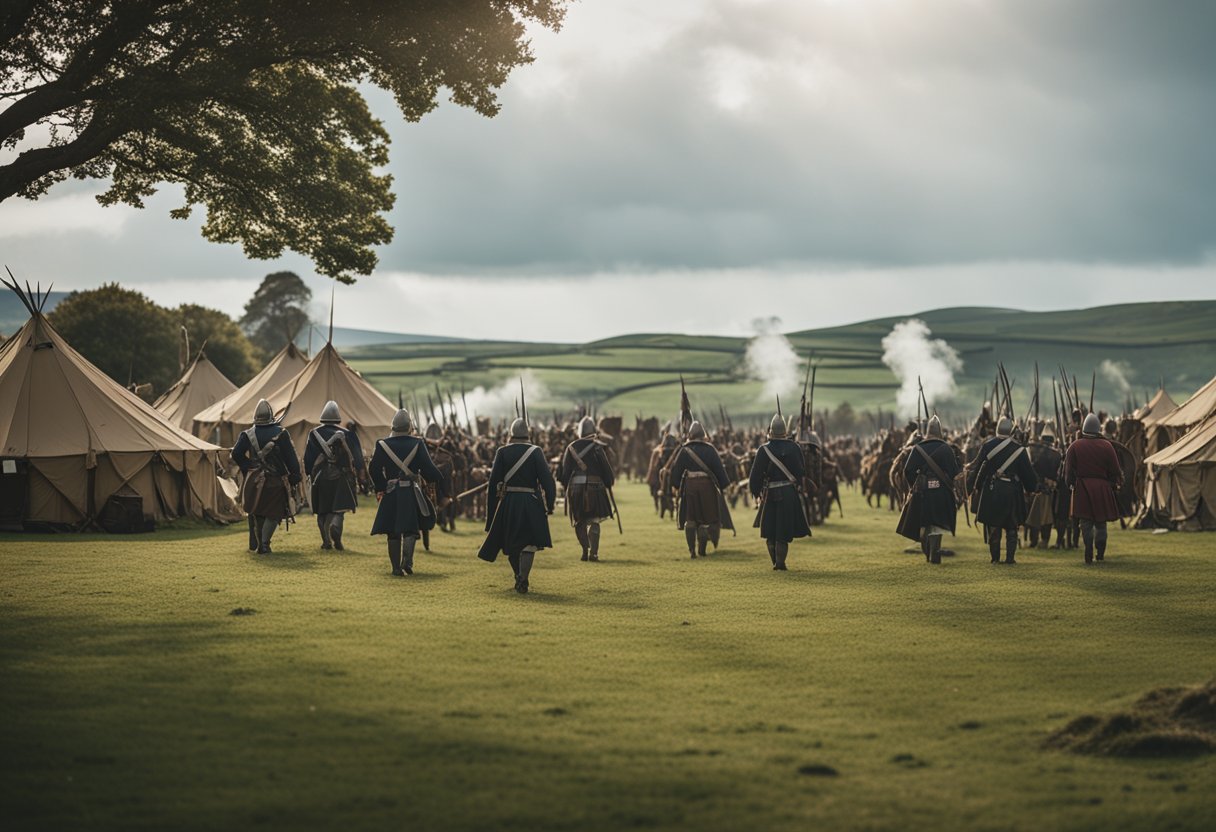
In medieval Ireland, our military equipment ranged from personal armour to siege weaponry, each item embodying its strategic purpose. The nature of warfare demanded that our fighters don armour, often a mix of leather and metal chainmail, to protect against the brutal impact of swords and axes. The advancement in metalworking skills reflected the influence and needs of trading dynasties, as their quest for domination shaped the market for fortified settlements and military gear.
Crafting swords and axes involved meticulous forging, with the iron and steel blades symbolising the might and skill of the wielder. The swords, featuring a cross-guard and a sturdy grip, also served as status symbols for warriors. On the other hand, axes, being easier to produce, were a common sight among the foot soldiers.
| Component | Description |
|---|---|
| Armour | Leather and chainmail with metal as needed |
| Swords | Iron/steel, cross-guard, status symbols |
| Axes | Common among infantry, less costly than swords |
Our fortifications, the focal point of many settlements, stood as testaments to military engineering. They were designed to repel invaders and ensure the survival of the inhabitants. Stone castles and towers rose from the landscape, controlled by powerful dynasties, and served as defensive structures and seats of governance and power. Building such fortifications often involved complex techniques and materials, evidence of a well-established network of skilled labour.
In essence, medieval Ireland’s military equipment and fortifications mirror the era’s complex interplay of power, protection, and prestige. Our warriors, equipped for battle and aided by the solidity of stone fortifications, were integral to shaping Ireland’s historic landscape.
Religious Influences and Church Dominance
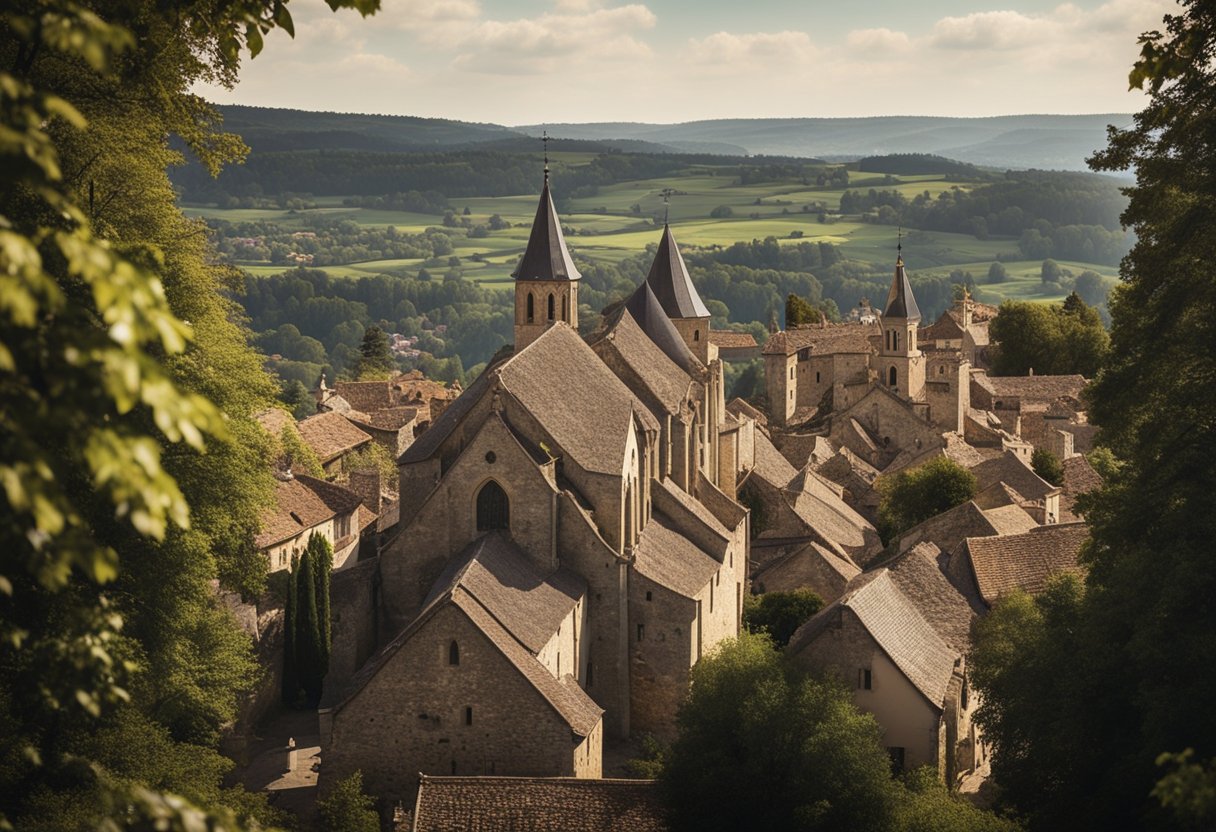
In medieval Ireland, the Church wielded significant influence over daily life, asserting a dominance rooted in the people’s spiritual and cultural identity. Monasteries stood as centres of learning and sanctuaries of faith, playing pivotal roles in communities across the land. The clergy, respected as emissaries of Rome, were instrumental in establishing moral standards and guiding the religious life of the populace.
The church’s authority was reinforced through reform efforts, ensuring clergy adhered to strict codes of conduct and spiritual disciplines. This pursuit of purity and order further trammelled the identity and purpose of the church within Irish society.
During periods of invasion and conflict, such as the frequent skirmishes with England, the church’s position often swayed, defending its holdings and influence while navigating the tumultuous political landscape. Successive waves of impact, notably the Reformation, brought profound shifts — straining the tethers between Ireland and Rome and introducing new doctrines and structures.
| Entity | Role in Medieval Ireland |
|---|---|
| Monasteries | Centres of learning & faith |
| Clergy | Guided religious life |
| Rome | Source of ecclesiastical authority |
| Invasion | Tested the church’s resilience |
| Reformation | Introduced doctrinal changes |
Despite facing challenges, the church’s hegemony in Ireland during the medieval period remained largely unchallenged, forging a societal structure that would only begin to transform with the advent of reformation and new political forces. Its impact on Ireland’s identity, culture, and governance was profound and enduring.
Frequently Asked Questions
In this section, we explore the complexities of medieval Irish society, from the intricate social hierarchy to the influences of pivotal battles. We’ll uncover the day-to-day lives of varied social classes, the economic cornerstones of the period, the cultural expressions in art and literature, and the integral role of religion.
What can be noted about the social structure of Gaelic Ireland during medieval times?
Medieval Gaelic Ireland was characterised by a tiered society where kinship and familial ties played a central role. The social structure was divided among the ruling elite, free landholders, and unfree peasants, with the family or ‘clann’ at the core of social and political power.
In what manners did legendary battles shape medieval Irish history?
Legendary battles such as the Battle of Clontarf in 1014 left an indelible mark on medieval Irish history. These conflicts often involved intricate alliances and rivalries and had lasting impacts on power dynamics and territorial control.
How did daily routines and responsibilities vary among different social classes in medieval Ireland?
Daily life in medieval Ireland varied considerably across the social spectrum. The nobility engaged in governance, warfare, and patronage of the arts, whereas the common folk, comprising farmers and craftsmen, focused on agricultural work, family, and community ties.
What were the economic foundations of medieval Irish society?
The medieval Irish economy was predominantly pastoral, relying heavily on livestock, especially cattle, a fundamental measure of wealth and exchange. Agriculture, craft, and trade also significantly sustained the economy.
How did medieval Irish culture manifest itself in art and literature?
Medieval Irish culture found expression through a rich oral tradition, illuminated manuscripts, and intricate metalwork. Works like the Book of Kells stand as a testament to this period’s artistic and literary proficiency.
What role did religion play in the everyday lives of medieval Irish people?
Religion was woven into the fabric of daily life in medieval Ireland. The Christian faith, guided by the Church, influenced education, provided social services, and was evident in the celebration of numerous religious festivals throughout the year.


